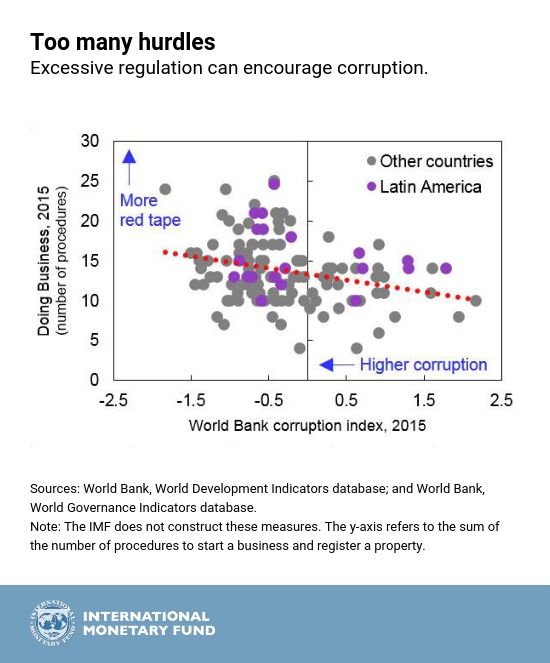September 28, 2017
Versions in Español (Spanish), Português (Portuguese)
[caption id="attachment_21471" align="alignnone" width="1024"] Sustained action on many fronts will be needed to push countries out of the corruption trap (photo: People Images/iStock). [/caption]
Sustained action on many fronts will be needed to push countries out of the corruption trap (photo: People Images/iStock). [/caption]
In our first blog of this two-part series, we noted that, despite recent progress, corruption in Latin America is still high. In this second blog, we look at measures to fight corruption that have worked well in other countries. Learning about these policies can provide insights to guide Latin America in the design of their anti-corruption strategies, even if the final shape of these policies will differ depending on country specifics.
We argue that a lasting solution will require sustained action on many fronts to create a major shift in societal expectations and to push countries out of the corruption trap. Improving institutions and lowering corruption go hand in hand, but this is easier said than done. Progress on paper (a better legal framework), while necessary, does not translate into results on the ground if it is not accompanied by stronger enforcement.
Renewed priority
Latin America’s fight against corruption is increasingly becoming a priority. The region has been an international front runner in adopting an anti-corruption convention (by the Organization of American States), which has been a model for others. Many countries in the region have either upgraded or are in the process of upgrading their legal and judicial frameworks (for example, Argentina, Brazil, Chile, Ecuador, Guatemala, Mexico, Paraguay, and Peru). In addition, several countries have introduced and enhanced asset declaration requirements, although their coverage and public access vary from country to country. Some are also taking measures to enhance fiscal transparency, including with IMF support.
What these changes imply for progress “on the ground” remains to be seen. Much will depend on enforcing upgraded legal frameworks. But concrete results are already palpable. Brazil’s recent path-breaking anti-corruption drive (Operation Car Wash) reflects a more efficient judiciary, independent and adequately resourced prosecutors, and decisive support from the media and society. Similarly, over the past few years, Guatemala successfully unveiled cases of tax evasion, money laundering, and illegal funding through its International Commission Against Impunity (the United Nations’ anticorruption body assisting national prosecutors). Among others, Peru and the Dominican Republic have forcefully pursued allegations against former high-level officials associated with the Odebrecht scandal.
Learning from others
Combatting corruption that is entrenched requires ending a corruption trap where the existing structure of incentives are self-perpetuating (read our first blog ). Breaking this inefficient equilibrium requires solving a collective action problem (putting up a fight against vested interests) and overcoming formidable political economy hurdles.
International experience suggests that an effective anti-corruption strategy requires strong legal frameworks, intensity of enforcement and clean-up, and perseverance. Strong national ownership and leadership are also critical to ensure that public support by broad segments of society is sustained throughout this long fight. Based on earlier country experiences, key elements of such a multifaceted strategy can include the following.
Role of task forces
A hurdle for any government fighting corruption is opposition from well-organized vested interests. If public officials and political parties are complicit, efforts to curb corruption may require setting up independent special task forces (Guatemala and more recently Ecuador).
Raising transparency and accountability
Greater transparency is fundamentally important to curb corruption. It increases the chances of detection for a given level of law enforcement. Traditional measures to increase transparency and accountability have been covered extensively in previous IMF work and include, among others, freedom of information laws, income and asset declarations, random audits, strengthening public management and fiscal transparency, especially in resource rich economies, and improving governance of state-owned enterprises.
But more can be done to push the boundaries of transparency and accountability.
-
To end corporate secrecy, beneficial ownership information for firms should be collected and can be made available through centralized corporate registries. Public and private entities involved in public procurement and investment could create internal anti-corruption committees reporting directly to the Board, Comptroller, or Auditor General to foster partnerships between internal stakeholders and external auditors.
-
Conflicts of interest could be addressed by suspending business activities of elected officials where this is currently not required.
-
Federal governments can help provide incentives for sub-national units to implement transparency best practices. To complement this, the IMF is focusing on promoting fiscal transparency.
Strengthening public procurement and investment processes
The ongoing corruption probes in the region highlight loopholes in public procurement, state-owned enterprises, and public-private partnerships, under otherwise sound legal frameworks. Stronger contractual frameworks and implementation, eliminating ad hoc exceptions, and possibly ruling out contract renegotiations in the short term can help close these fiscal loopholes and help establish a Transparency Framework. Efforts could also include ensuring competitive auctions, mandatory bidding for any additional public spending needs, providing full information on awarded contracts and modifications, tracking of procurement spending, and developing policies to minimize the rent seeking corrupt practices in land tenure and zoning.
Eliminating unnecessary rules
Too much regulation provides fertile ground for corrupt behavior by creating artificial sources of revenues (for instance, rationed import licenses). Enhancing competition and lowering red tape are thus key ingredients to fighting corruption (Ukraine).
Dealing with the short run costs
Successful efforts to uncover corruption can nonetheless create uncertainty in the short term. This can hinder public sector decision making and forestall investment. While long-run benefits far exceed short-run costs when it comes to institution building, the latter can arguably prevent change from happening. In this context, measures to curtail such transition costs would help support the process and could include improving judicial frameworks to avoid lengthy legal procedures, a clear framework to handle leniency agreements and plea bargaining, and a flexible and efficient bankruptcy law—ensuring that assets remain operational. In addition, lending facilities could be carefully designed to soften a credit crunch during periods of heightened uncertainty.
A way forward
At the end of the day, breaking corruption requires standing up against powerful vested interests—both private and government—who benefit from the status quo. While the measures listed above are, by themselves, incomplete, a big push on multiple fronts could overcome many hurdles. But there is no fixed formula and learning by doing will be an important part of the process. The IMF, through our legal and financial experts, will continue to provide advice to the region on ways to combat corruption and contribute to international cooperation.
Recent popular pressures have opened a rare window of opportunity in Latin America to maintain the reform momentum, but efforts are also needed to tackle transition costs toward achieving a more just society and stronger economy for all.




